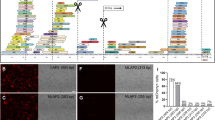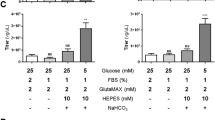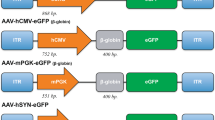Abstract
Macrophage-derived TNFα is a critical mediator of inflammation and destruction in diseases such as rheumatoid arthritis and Crohn's disease. These studies were undertaken to develop an effective adenovirus-based strategy to specifically suppress TNFα in primary human macrophages. A variety of promoters and LTRs were evaluated for effective expression in the macrophage cell line RAW 264.7. The CMV promoter and the Visna LTR were the most strongly expressed and were therefore used to drive the expression of TNFα antisense fragments. In transient transfection assays, the antisense fragment terminating at the 3′ end of the first exon (216 bp) was superior to the others (70 and 750 bp), when expressed under the control of either the CMV promoter or the Visna LTR. Adenoviral vectors expressing the 216 bp TNFα antisense fragment, controlled by the CMV promoter or the Visna LTR, were both effective at suppressing LPS-induced TNFα secretion by primary human macrophages. However, the Visna LTR was more effective not only at suppressing LPS-induced TNFα secretion, but also IL-6, which is highly sensitive to TNFα secretion. These results demonstrate that effective, specific, suppression of TNFα in macrophages is possible, employing a directed antisense approach and a promoter system that is highly efficient in human macrophages.
This is a preview of subscription content, access via your institution
Access options
Subscribe to this journal
Receive 12 print issues and online access
$259.00 per year
only $21.58 per issue
Buy this article
- Purchase on Springer Link
- Instant access to full article PDF
Prices may be subject to local taxes which are calculated during checkout





Similar content being viewed by others
References
Feldmann M, Brennan FM, Maini RN . Role of cytokines in rheumatoid arthritis Annu Rev Immunol 1996 14: 397–440
Butler DM, Maini RN, Feldmann M, Brennan FM . Modulation of proinflammatory cytokine release in rheumatoid synovial membrane cell cultures. Comparison of monoclonal anti-TNF-alpha antibody with the interleukin-1 receptor antagonist Eur Cytokine Netw 1995 6: 225–230
MacNaul KL et al. Analysis of IL-1 and TNF-a gene expression in human rheumatoid synoviocytes and normal monocytes by in situ hybridization J Immunol 1990 145: 4154–4166
Elliott MJ et al. Randomized double-blind comparison of chimeric monoclonal antibody to tumor necrosis factor a (cA2) versus placebo in rheumatoid arthritis Lancet 1994 344: 1105–1110
Moreland LW et al. Treatment of rheumatoid arthritis with a recombinant human tumor necrosis factor receptor (p75)-Fc fusion protein N Engl J Med 1997 337: 141–147
Hartmann G et al. Specific suppression of human tumor necrosis factor-a synthesis by antisense oligodeoxynucleotides Antisense Nucleic Acid Drug Dev 1996 6: 291–299
Mayne M, Ni W, McKenna R, Power C . Antisense oligodeoxynucleotides targeting internal exon sequences efficiently regulate TNF-α expression Antisense Nucleic Acid Drug Dev 1999 9: 135–144
Taylor M, Weller D, Zobzik L . Effect of TNF-α antisense oligomers on cytokine production by primary alveolar macrophages Antisense Nucleic Acid Drug Dev 1998 8: 199–205
Tu G-C, Cao Q, Zhou F, Israel Y . Tetranucleotide GGGA motif in primary RNA transcripts J Immunol 1998 273: 25125–25131
d'Hellencourt C, Diaw L, Cornillet P, Guenounou M . Inhibition of human TNFa and LT in cell-free extracts and in cell culture by antisense oligonucleotides Biochim Biophys Acta 1996 1317: 168–174
Evans CH et al. Gene therapy for rheumatic diseases Arthritis Rheum 1999 42: 1–16
Miller N, Whelan J . Progress in transcriptionally targeted and regulatable vectors for genetic therapy Hum Gene Ther 1997 8: 803–815
Small JA et al. The visna virus long terminal repeat directs expression of a reporter gene in activated macrophages, lymphocytes, and the central nervous systems of transgenic mice J Virol 1989 63: 1891–1896
Bellosta S et al. Macrophage-specific expression of human apolipoprotein E reduces atherosclerosis in hypercholesterolemic apolipoprotein E-null mice J Clin Invest 1995 96: 2170–2179
Deforge LE et al. Biphasic production of IL-8 in lipopolysaccharide (LPS)-stimulated human whole blood: separation of LPS- and cytokine-stimulated components using anti-tumor necrosis factor and anti-IL-1 antibodies J Immunol 1992 148: 2133–2141
Charles P et al. Regulation of cytokines, cytokine inhibitors, and acute-phase proteins following anti-TNF-α therapy in rheumatoid arthritis J Immunol 1999 163: 1521–1528
Zagariya A et al. Tumor necrosis factor alpha gene regulation: enhancement of C/EBPβ-induced activation by c-Jun Mol Cell Biol 1998 18: 2815–2824
Liu H et al. TNF-α gene expression in macrophages: regulation by NF-κB is independent of c-Jun or C/EBPβ J Immunol 2000 164: 4277–4285
Pope RM, Leutz A, Ness SA . C/EBPβ regulation of the tumor necrosis factor alpha gene J Clin Invest 1994 94: 1449–1455
Smits PH, de Wit L, van der Eb AJ, Zantema A . The adenovirus E1A-associated 300 kDa adaptor protein counteracts the inhibition of the collagenase promoter by E1A and represses transformation Oncogene 1996 12: 1529–1535
Clarke S et al. The human lysozyme promoter directs reporter gene expression to activated myelomonocytic cells in transgenic mice Proc Natl Acad Sci USA 1996 93: 1434–1438
Economou JS et al. Genetic analysis of the human tumor necrosis factor α/cachectin promoter region in a macrophage cell line J Exp Med 1989 170: 321–326
Pope R, Mungre S, Liu H, Thimmapaya B . Regulation of TNF-a expression in normal macrophages: role of C/EBPβ Cytokine 2000 12: 1171–1181
Ghadge GD, Swaminathan S, Katze M, Thimmapaya B . Binding of the adenovirus VAI RNA to interferon induced 68 kDa protein kinase correlates with function Proc Natl Acad Sci USA 1991 88: 7140–7145
Thimmappaya B, Weinberger C, Schneider RJ, Shenk T . Adenovirus VAI RNA is required for efficient translation of viral mRNAs at late times after infection Cell 1982 31: 543–551
Kaspers GJ et al. In vitro cellular drug resistance and prognosis in newly diagnosed childhood acute lymphoblastic leukemia Blood 1997 90: 2723–2729
Coll J et al. Mapping by in vitro constructs of the P100gag-mil region, accounting for induction of chicken neuroretina cell proliferation J Virol 1988 62: 2808–2816
Acknowledgements
This work supported by NO1-AR-6–2229, from the National Institute of Arthritis, Musculskeletal and Skin Diseases. We thank Harris Perlman, PhD for helpful discussions and for assistance in preparation of the Figures.
Author information
Authors and Affiliations
Rights and permissions
About this article
Cite this article
Sidiropoulos, P., Liu, H., Mungre, S. et al. Efficacy of adenoviral TNFα antisense is enhanced by a macrophage specific promoter. Gene Ther 8, 223–231 (2001). https://doi.org/10.1038/sj.gt.3301368
Received:
Accepted:
Published:
Issue Date:
DOI: https://doi.org/10.1038/sj.gt.3301368



